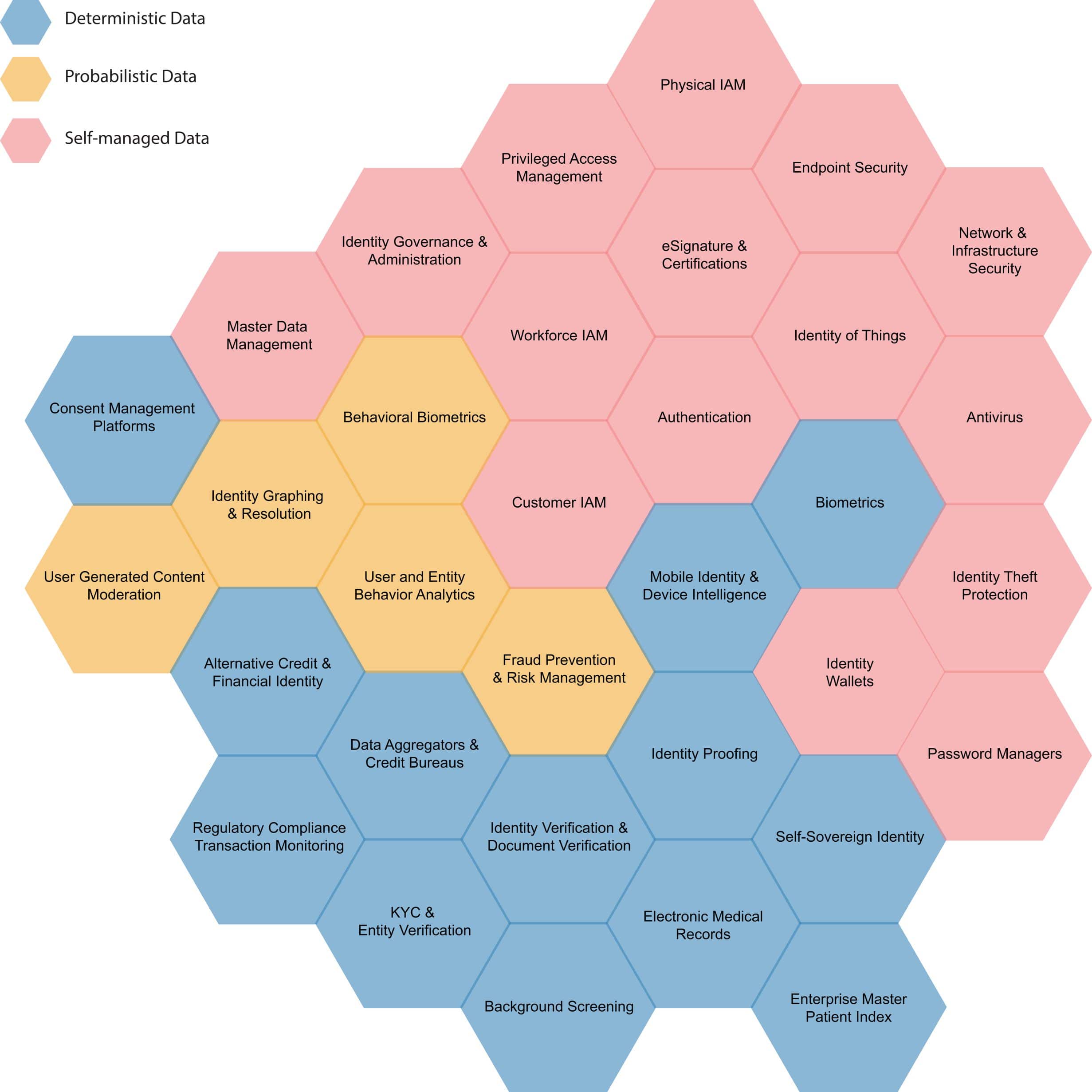Digital Identity Landscape 2021
landscape
2021 Digital Identity
Landscape v.2.0
In the five years that we analyzed the evolution of the Digital Identity Landscape, we’ve found innovation to be a consistent linchpin; a reliable indicator of what the future might hold. In 2020, though, the pandemic’s impact was unprecedented. It forced enterprises, institutions, and governments to transform, prioritizing Digital Identity and placing it squarely in the sights of investors and end-users alike.
 Physical IAMPrivileged Access ManagementEndpoint SecurityIdentity Governance and AdministrationeSignatures + CertificationsNetwork & Infrastructure SecurityMaster Data ManagementWorkforce IAMIdentity of Things (IDIoT)Consent Management PlatformsBehavioral biometricsAuthenticationAntivirusIdentity Grpahing & ResolutionCustomer IAM (CIAM)BiometricsUser Generated Content ModerationUser + Entity Behavior Analytics (UEBA)Mobile Identity & Device IntelligenceIdentity Theft ProtectionAlternative Credit & Financial IdentityFraud Prevention + Risk ManagementIdentity WalletsData Aggregators & Credit BureausIdentity ProofingPassword ManagersRegulatory Compliance Transaction MonitoringIdentity Verification & Document VerificationSelf-Sovereign Identity (SSI)KYC + KYB / Entity VerificationElectronic Medical RecordsBackground ScreeningEnterprise Master Patient Index (EMPI)
Physical IAMPrivileged Access ManagementEndpoint SecurityIdentity Governance and AdministrationeSignatures + CertificationsNetwork & Infrastructure SecurityMaster Data ManagementWorkforce IAMIdentity of Things (IDIoT)Consent Management PlatformsBehavioral biometricsAuthenticationAntivirusIdentity Grpahing & ResolutionCustomer IAM (CIAM)BiometricsUser Generated Content ModerationUser + Entity Behavior Analytics (UEBA)Mobile Identity & Device IntelligenceIdentity Theft ProtectionAlternative Credit & Financial IdentityFraud Prevention + Risk ManagementIdentity WalletsData Aggregators & Credit BureausIdentity ProofingPassword ManagersRegulatory Compliance Transaction MonitoringIdentity Verification & Document VerificationSelf-Sovereign Identity (SSI)KYC + KYB / Entity VerificationElectronic Medical RecordsBackground ScreeningEnterprise Master Patient Index (EMPI)
Impacts on the Digital Identity Landscape in 2021
Through the year, the rate of investment didn’t slow: a total of $247B was raised by 14,000 companies. The pandemic brought with it a need to offer a suite of Digital Identity offerings instead of a single solution or product. It created the potential for infinite regress in an already partnership-heavy market.
Today, the market includes over 3,000 companies and is worth a staggering $210B, growing at a 19% CAGR
The Liminal Digital Identity Landscape is a tool and framework we’ve developed to help provide an in-depth look at how Digital Identity applications are evolving and how intersections across solution segments are shaping next-generation strategies. Below is an example of one of the many framework overlays we use to assess the Landscape – click through the honeycombs to learn more about each segment. We will be publishing more landscape framework overlays and assessments throughout 2021.
Our unique honeycomb design provides a roadmap through the different solution segments within the space, showcasing not only their relationships and hierarchy but also identifying how they come together to address unique Digital Identity challenges.
These challenges can include data, technology, business models, or other issues that arise within Digital Identity. The design also helps to identify use cases that drive demand in the space. With this knowledge, companies can understand what technology is available, what solutions segments have become mission-critical, where investments are flowing, and the spaces that require more innovation.
As with every year, our Digital Identity Landscape provides insight into a dramatically shifting industry. What’s unique about this year is the adoption of Digital Identity awareness, interest, and use cases from a largely secondary set of users: The consumer.
It’s a shift that moves the importance of Digital Identity – including privacy and security – from the back rooms of corporate offices and into people’s homes. In the maturation process of the industry, it’s a seismic opportunity, providing the potential for new lines of businesses and opening entirely new markets for the right strategies.
The Consumer-Driven
Demand For Digital Identity
The pandemic forced consumers and businesses alike to adopt more digital tools. This encouraged industry to improve procedures and make them easier for consumers to understand and handle. From the Landscape above, it’s clear that the adoption of Digital Identity tools has more room to grow in the form of digital credentials and eSignatures, Digital Identity Wallets, and Mobile Identity applications, among other segments.
The difficulty of this trend is the lack of understanding, patience or time from the consumer side. The Digital Identity industry hasn’t done enough to quell many of these concerns. Take some of the most common issues identified within the consumer space:

Consumers feel the brunt of industry fragmentation
The average internet user in the US manages, on average, 150 online accounts requiring a password, a number expected to double by 2022

Friction remains a massive problem
About 25% of all financial services applications are abandoned due to friction in the Know Your Customer (KYC) process, in part because current Identity Verification (IDV) procedures fail users

Consumers demand privacy and control
Nearly 80% of Americans are very or somewhat concerned about how companies use their data, according to a 2019 survey by Pew Research

The consumer education gap hasn’t narrowed
One in four consumers consider themselves uninformed about cybersecurity, while more than half say they could do more to protect their personal information online

Fraud and theft still exist
Identity theft and fraud cost 15.4 million consumers over $16 billion last year
Two very important takeaways come from these consumer insights. First, consumers don’t want to have to pay to solve these problems. They don’t understand the issues involved and even fewer know the best way to circumnavigate the hurdles. It’s becoming a competitive advantage for enterprises that incorporate these fixes and solutions for the consumer, which led to a significant shift towards consolidation.
Second, it creates an opportunity for forward-thinking organizations that offer a way to solve these issues for the consumer, more directly.
This moves the identification industry from one that has focused on B2B or B2B2C designs, to one that can operate in B2C as well.
This shift has homed in on taking current tools and technologies and presenting them more for the at-home customer rather than building specific tools unique to a consumer.
Areas That Shifted In 2020
Last year, Digital Identity continued to build on the shifts we have been charting since 2016. We’ve had the opportunity to measure the influence each segment has over its adjacent segments and refine our strategy offerings to more accurately predict trends. The result is a landscape with four new segments, mostly focused on cybersecurity, and a few consolidated segments, primarily centered in martech.
We often use our landscape framework to identify Golden Cog opportunities. These opportunities are extremely valuable as integrated partners because they are required to enable platform solutions. Golden Cogs can be found within the center of the framework (watch more about our Golden Cog framework and the 2021 landscape). We used our framework and Golden Cog Methodology to correctly predict the expanded influence of Identity Proofing, Identity Resolution, and Mobile Identity as Golden Cog opportunities.
We’ve consolidated the Identity Graphing and Identity Resolution segments into one unit, as a result of an increase in consumer demands. This played out with companies like Experian acquiring Tapad. While we remain very bullish on the Identity Resolution market (they remain a Golden Cog Opportunity, after all), the bulk of companies didn’t make the appropriate shifts this year.
COVID-19 also greatly impacted the landscape, as the world went from in-person to remote. Identity Proofing and Verification segments were the big winners on this front, shifting from enabling solutions within a stack, to becoming platform solutions of their own. Investors have supported this claim by buying into third-wave companies like Passbase, Persona, Berbix, and Veriff.
One of the biggest movements this year occurred in the eSignature and Certs space, which shifted towards the Identity of Things solution segment. Certs, in particular, have an opportunity in the ID IoT platforms, which further prompted this move. Additionally, we saw an increase in the area of influence for Consent Management and Master Data Management platforms, splitting each of those out into their own segments, respectively.
Moving Through 2021
We expect to see many of these trends to continue through 2021. Expect consumer rights to expand, forcing companies to shift towards privacy-by-design, offering new opportunities for large B2C enterprises looking to enter the Digital Identity space. At the same time, Digital Identity companies will grow, merge, and acquire each other, forming integrated identity solutions instead of single point-solutions. To support this, private equity and strategic enterprises will continue investing in the space.
We’re only at the beginning of this journey. There’s a lot of work to do, but one thing remains clear: The opportunity for those who focus on building Digital Identity products and services remains enormous.
